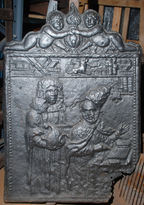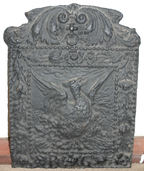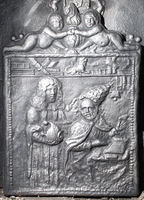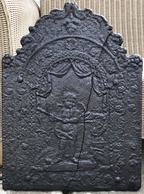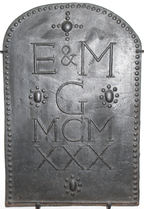-
216
Description: Rectangular with plait-effect border and a column of beads down each side; pictorial scene of a male figure in gown and full-bottom wig, holding a fool’s cap in his right hand, standing behind a seated male figure, bald and bearded, with the papal triple crown falling off his head; he is seated at a desk on which are two books; behind him and to the right, three books are on a small shelf. Above the figures, a longer shelf, the width of the plate, supports other books and papers, together with the figure of a dog, from whose mouth a scroll issues bearing an unreadable inscription. On top, two putti hold hands in front of a flaming grenade.
Notes: The design is copied from a cartoon of c.1672 showing Titus Oates, the instigator of the Popish Plot, presenting a fool’s cap to the Pope.
Copies of this fireback are known.
- Decoration tags:
- rectangular with ornate arch (shape)
- bead (edging)
- whole carved pattern
- pictorial
- humans
- objects
Manufactured: in the mid- to late-17th century in England.
Current location: Brighton Museum and Art Gallery, Brighton, East Sussex, England.
Museum number: HA105014 (part of the Brighton Museum museum group)
- Attached to series:
- Commemorative firebacks
-
35
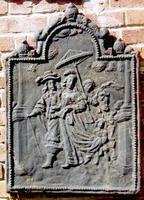 ? x ? mm
? x ? mmDescription: 'Dutch' style; arched rectangular shaped with bead edging; figures of a man and woman walking, in dress of the mid-17th century, a page holding the woman's train. followed by a man holding a parasol, and by a horse; they pass between the bases of two columns; above is foliage and clouds. On top are two serpents and three pomegranates arranged symmetrically.
Notes: The pictorial scene is based on an engraving c.1642 of Friedrich Wilhelm, Elector of Brandenburg, and his wife, Luise Henriette of Oranje-Nassau, by Mathias Czwiczek; one of series of firebacks depicting allegories of the four continents.
Copies of this fireback are known.
Manufactured: in the mid-17th century .
Current location: in private hands, Chichester, West Sussex, England.
- Attached to series:
- 'Dutch' Continents firebacks
- 'Dutch' Borderless series
-
154
Description: Rectangular central panel with bead edging; a phoenix, with wings displayed, rising from the flames; rectangular border with bead edging, flowers and leaves festooned from a central flower; initials split either side of a flower at the base; on top, symmetrical swirled leaves.
Notes: Although similar to 'Dutch' types made in north Germany, this is probably an English design. A fireback bearing a phoenix was one of three designs ordered by Trubshaw's, ironmongers of London and Birmingham, from George Sitwell's furnace at Foxbrooke, Derbyshire, in the 1660s. Formerly part of the Ade Collection (from Grove Hill, Hellingly, Sussex).
Copies of this fireback are known.
Inscription: R (or B) G
- Decoration tags:
- 'Dutch' (shape)
- bead (edging)
- whole carved pattern
- individual letters
- mythological
- text
- animals
Manufactured: in the mid- to late-17th century in England.
Current location: Hastings Museum and Art Gallery, John's Place, Bohemia Road, Hastings, East Sussex, England.
Museum number: HASMG: 1952.51.16 (part of the Hastings Museum museum group)
Citation: Lloyd, N., 1925, 'Domestic Ironwork I', Architectural Review, 58, pp. 58-67.
Citation: Riden, P., 1985, George Sitwell's Letterbook, 1662-66 (Derbyshire Record Society vol. 10).
- Attached to series:
- British 'Dutch' style firebacks
- Phoenix firebacks
-
417
Description: Rectangular central panel with top arch, bead edging; pictorial scene of a a kneeling man in a wide-brimmed hat reaching up the skirt of a milk maid, who in fending him off, leans forward, tipping the milk from the bucket on her head over the man; acanthus leaves over the top arch; side border with bead edging extending over shoulders of plate, surmounted by a floral vase each side; on top a floral vase between leaves.
Notes: Inscription on the back of the casting: 'Made from a casting lent to J. H. E[very] by Mr J. T. Ade of Hellingly'.
Copies of this fireback are known.
- Decoration tags:
- 'Dutch' (shape)
- bead (edging)
- whole carved pattern
- pictorial
- humans
Manufactured: in the early-18th century in England.
Current location: Anne of Cleves House, Southover High Street, Lewes, East Sussex, England.
Museum number: 1944.24.081 (part of the Sussex Archaeological Society museum group)
Citation: Lloyd, N., 1925, 'Domestic Ironwork I', Architectural Review, 58, pp. 58-67.
- Attached to series:
- Miscellaneous pattern firebacks
-
446
Description: Arched rectangular; bead edging; pictorial scene of Venus, naked and kneeling, and Adonis, standing, holding a spear in his left hand, with Cupid to the left, and a hound to the right; pomegranates on top and on each shoulder of the plate, with two symmetrical, descending serpents.
Notes: Probably based on one of two paintings of Venus and Adonis by Peter Paul Rubens.
Copies of this fireback are known.
- Decoration tags:
- 'Dutch' (shape)
- bead (edging)
- whole carved pattern
- pictorial
- mythological
- humans
Manufactured: in the mid- to late-17th century in the Siegerland area of Germany.
Current location: Anne of Cleves House, Southover High Street, Lewes, East Sussex, England.
Museum number: LH000.971 (part of the Sussex Archaeological Society museum group)
- Attached to series:
- 'Dutch' Borderless series
- 'Dutch' Venus and Adonis firebacks
-
609
Description: Rectangular with plait-effect border and a column of beads down each side; pictorial scene of a male figure in gown and full-bottom wig, holding a fool’s cap in his right hand, standing behind a seated male figure, bald and bearded, with the papal triple crown falling off his head; he is seated at a desk on which are two books; behind him and to the right, three books are on a small shelf. Above the figures, a longer shelf, the width of the plate, supports other books and papers, together with the figure of a dog, from whose mouth a scroll issues bearing an unreadable inscription. On top, two putti hold hands in front of a flaming grenade.
Notes: The design is copied from a cartoon of c.1672 showing Titus Oates, the instigator of the popish Plot, presenting a fool’s cap to the Pope (see Hodgkinson 2010, p.209).
Copies of this fireback are known.
- Decoration tags:
- rectangular with ornate arch (shape)
- bead (edging)
- whole carved pattern
- pictorial
- humans
- objects
Manufactured: in the late-17th century in England.
Current location: Mark Ripley Forge & Fireplaces, Northbridge Street, Robertsbridge, East Sussex, England.
- Attached to series:
- Miscellaneous pattern firebacks
-
1263
Description: Arched rectangular shaped central panel with hollow bead edging; a putto, its head inclined to its left, standing on a platform, holding a wand in its right hand and a branch in its left hand, a flower in a pot is on each side, and above, swagged drapery; arched rectangular shaped border with fillet edging; swirled flowers and tendrils symmetrically arranged, with SHR monogram at centre bottom; two mirrored stylised sea serpents on top; to each side a vertical extension with bead edging, of the same decoration as the side borders.
Notes: The figure depicted is probably emblematic although the meaning has yet to be determined. The frame of the central panel and the enclosing border are identical to those noted on another fireback displaying a figure of Pluto (see fireback no. 164). This may be an example of an image from one casting being superimposed within the frame of an earlier fireback. The border is identical to that seen on fireback no. 1220.
Inscription: SHR
- Decoration tags:
- 'Dutch' (shape)
- bead (edging)
- whole carved pattern
- extension panels
- pictorial
- allegorical
- monogram
- text
- humans
- plants
- objects
Manufactured: in the early-18th century in England.
Current location: not known.
- Attached to series:
- British 'Dutch' style firebacks
-
1220
Description: Arched rectangular shaped central panel with hollow bead edging; to the right, a seated male figure beside a wellhead, pointing towards a standing female resting a ewer on the wellhead over which a rope hangs, and behind the male figure is a tree, and above, swagged drapery; arched rectangular shaped border with fillet edging; swirled flowers and tendrils symmetrically arranged, with SHR monogram at centre bottom; two mirrored stylised sea serpents on top; to each side a vertical extension with bead edging, of the same decoration as the side borders.
Notes: The frame of the central panel and the enclosing border are identical to those noted on another fireback displaying a figure of Pluto (see fireback no. 164), while the pictorial scene, of Jesus and the Woman of Samaria (St John 4: 5-28) is more typical of continental firebacks and stoveplates. This may be an example of an image from one casting being superimposed within the frame of an earlier fireback. The central image is sharper than the surrounding border.
Inscription: SHR
- Decoration tags:
- 'Dutch' (shape)
- bead (edging)
- whole carved pattern
- extension panels
- pictorial
- biblical
- monogram
- text
Manufactured: in the late-17th to early-18th century in England.
Current location: not known.
- Attached to series:
- British 'Dutch' style firebacks
-
774
Description: Arched shape with bead edging; from top, large bead with four pairs of small beads in a cross shape, text with pellet surrounded by eight beads on each side of 'G', and at bottom.
Notes: Made by, and bearing the initials of Eric Gill and his wife, Mary, in 1930.
Inscription: E&M / G / MCM / XXX
- Decoration tags:
- rounded arched (shape)
- bead (edging)
- whole carved pattern
- text
Manufactured: in 1930 at Loosley Row Foundry possibly in the Chilterns area of England.
Current location: Victoria & Albert Museum, Cromwell Road, Kensington & Chelsea, Greater London, England.
Museum number: M.4-1983 (part of the Victoria & Albert Museum museum group)
- Attached to series:
- Personal firebacks
- Miscellaneous stamp firebacks
